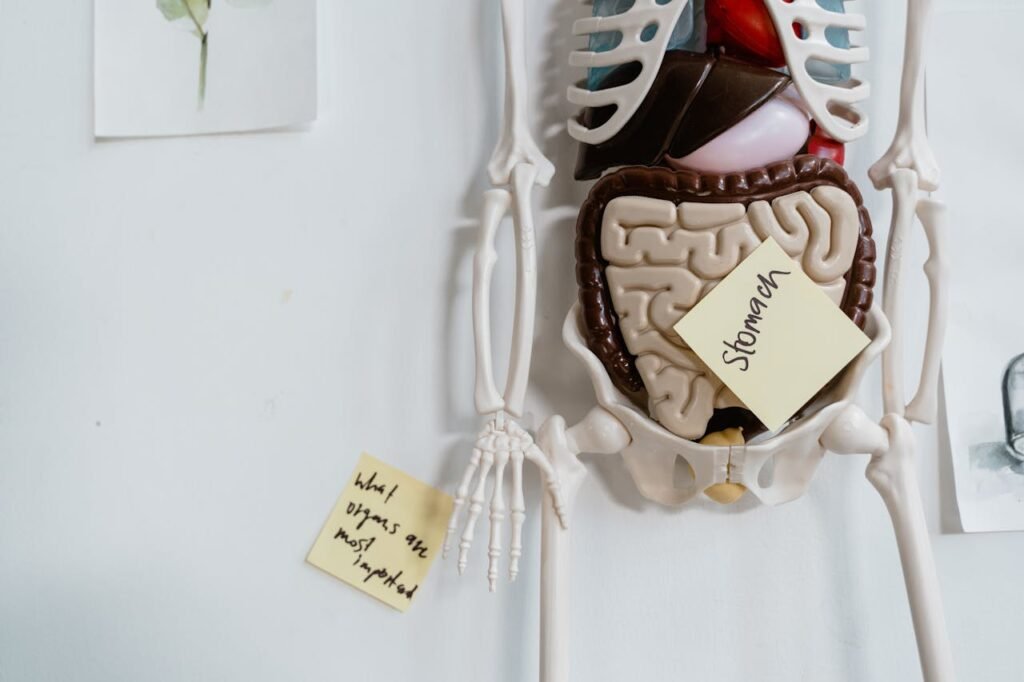Think of your favorite meal — maybe it’s spaghetti, toast, or a piece of fruit. You take a bite, chew, and swallow. Then, without much thought, your body turns that food into the energy that helps you run, think, play, and even dream.
This happens through something called the digestive system — a wonderful and busy team of organs inside you that take food and turn it into power. And all this starts with one simple action: a bite.
In this article, we’re going to go step by step — from that first bite, all the way to the moment your cells feel that energy. I’ll explain how every part works, using simple words and clear examples, like we’re sitting side by side talking it out. No fancy science words, no confusion — just a friendly walk through how your body takes food and turns it into energy.
Let’s begin this journey — one bite at a time.
Where Digestion Begins: Your Mouth

The moment you take a bite of food, your digestive journey starts. Your mouth is not just for tasting — it’s where food gets broken down so your body can start using it.
Chewing – The First Step
Your teeth chew and crush the food into smaller pieces. This makes it easier for your body to handle. But chewing isn’t just about smashing food. As you chew, your tongue helps move the food around so all your teeth get a turn.
This helps your food mix with something very important — saliva.
Saliva – Your Mouth’s Helper
Saliva (spit) is more than just wet stuff. It comes from special glands in your mouth and has tiny helpers called enzymes. These helpers begin to break down starchy foods, like bread or rice, into simpler sugars.
So even before your food leaves your mouth, digestion has already begun!
Once the food is soft and mushy, your tongue gently pushes it to the back of your mouth — and you swallow.
Down the Hatch: The Esophagus
After you swallow, your food doesn’t just drop into your stomach. It travels down a long, stretchy tube called the esophagus (say: eh-SOF-uh-gus).
This tube connects your mouth to your stomach. But food doesn’t fall down — it’s pushed.
Your esophagus gently squeezes the food using muscles in a wave-like motion. This is called peristalsis, but don’t worry about the name. Just imagine it like a slow-moving slide that guides food into your stomach.
It takes just a few seconds for the food to reach its next stop — the stomach.
The Stomach – Where Food Gets Mixed and Mashed
Your stomach is like a stretchy bag made of strong muscle. It holds the food and begins to mix it with juices that help break it down even more.
When the food reaches your stomach:
- Your stomach squeezes and churns it
- Acid and enzymes break it into smaller parts
- Food turns into a thick, soft soup called chyme (rhymes with time)
This process takes a few hours, depending on what you ate. Big meals or foods with fat take longer than simple snacks.
The goal? To turn your food into a form that your body can absorb and use.
Into the Small Intestine – Where Food Turns into Fuel
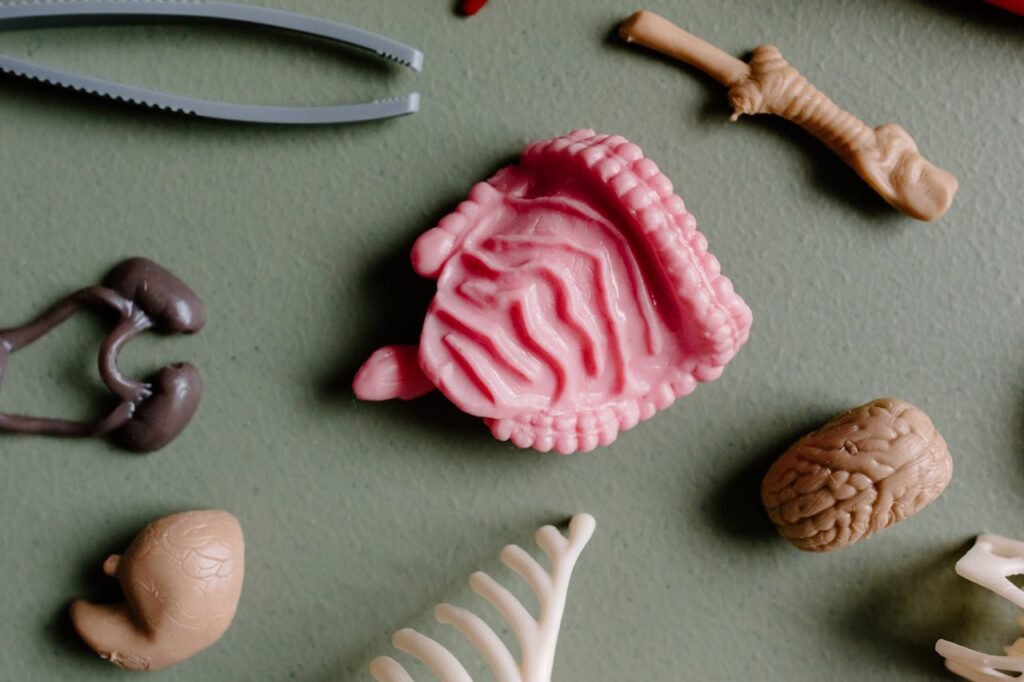
After your food has been mashed up into thick soup (chyme) in your stomach, it slowly moves into a long, twisty tube called the small intestine.
Now, even though it’s called “small,” the small intestine is actually super long — about 20 feet! It’s just called “small” because it’s thinner than the large intestine.
This is the most important stop on the digestive journey. Why? Because this is where your body actually absorbs the nutrients — the good stuff — from your food.
What Happens in the Small Intestine?
As the food soup moves through, your body does two things:
- Adds juices from helper organs
Two special helpers — the liver and the pancreas — send juices into the small intestine.- The liver makes bile, which helps break down fat.
- The pancreas makes enzymes that break down proteins, carbs, and fats.
- Pulls nutrients into your blood
The walls of your small intestine are lined with tiny fingers called villi (say: VILL-ee). These villi pull out all the nutrients — like vitamins, sugar, proteins, and minerals — and send them into your blood.
From there, your blood carries those nutrients all over your body — to your brain, your muscles, your bones — everywhere that needs energy to grow and work.
What’s Left Goes to the Large Intestine
After your body takes all the useful parts out of your food, what’s left behind moves into the large intestine. This is the body’s cleanup area.
The large intestine is shorter but thicker. Its job is to:
- Soak up water
- Turn leftover food into solid waste (poop)
- Get it ready to leave your body
This part takes a little longer — maybe a day or two. But in the end, your body sends out the waste it doesn’t need, and your digestive journey is complete.
So, what started as a bite of food became:
- A mushy soup in your stomach
- A stream of energy in your small intestine
- And, finally, waste in your large intestine
Your body is incredible — and it does this every single day, often without you even noticing.
Your Brain and Belly Talk All the Time
You might think your stomach works on its own, but guess what? It listens to your brain — all the time!
Have you ever felt butterflies in your belly before a big test or show? That’s your brain talking to your stomach. Or maybe you felt like you couldn’t eat when you were nervous — that’s digestion slowing down.
The brain and the belly are best friends. Scientists even call the gut the body’s “second brain” because of how many nerves are in it. That means how you feel — excited, stressed, scared, or calm — can change how well you digest your food.
When You Move, Digestion Improves
After you eat, sitting still for a little while helps your food settle. But moving your body later — like going for a walk, stretching, or playing outside — helps your digestion stay smooth.
Here’s why:
- Movement helps your intestines gently squeeze and push food along.
- It also helps reduce bloating or tummy aches.
- And it makes your body feel energized, not sleepy and slow.
Too much sitting or lying down right after eating can sometimes make digestion slower or uncomfortable. That’s why it’s good to stay gently active throughout the day.
What Helps Digestion Stay Healthy?
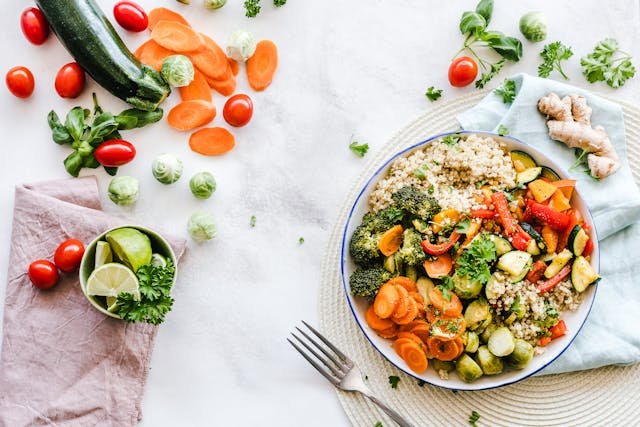
Your digestive system is like a big kitchen that works behind the scenes. When it’s happy, you feel full of energy, your tummy feels light, and everything flows just right. But when it’s upset, you might feel slow, gassy, or even have a tummy ache.
The good news? You can help your digestion stay healthy just by treating your body with care. Here’s how:
1. Chew Slowly and Mindfully
Chewing isn’t just about breaking food down. It’s actually the first and very important part of digestion.
When you chew:
- Your teeth make the food smaller and easier to swallow.
- Your saliva (spit) mixes with the food and starts breaking down starches.
- Your brain sends a signal to your stomach: “Food is coming! Get ready!”
If you chew too fast or take huge bites, your stomach has to work harder. That can lead to bloating or gas. So slow down. Put your spoon or fork down between bites. Enjoy your food.
Chewing well is like giving your tummy a head start.
2. Eat Fresh, Colorful Foods
Foods that grow from the earth — like fruits, vegetables, whole grains, and nuts — have something magical called fiber. Fiber is like a soft broom for your intestines. It helps move everything along so you can go to the bathroom easily and often.
Some kid-friendly fiber foods include:
- Apples (with the skin)
- Carrots
- Brown rice
- Beans
- Berries
- Oats
These foods don’t just help with digestion — they also feed the good bacteria in your gut that help your belly stay strong.
Processed or sugary snacks don’t offer much fiber. So balance your treats with natural foods that love your gut back.
3. Drink Water Often
Water is the best drink for your digestion. It keeps the food soft as it moves through your system. It also:
- Helps your intestines move better
- Prevents constipation
- Helps you absorb nutrients
Sometimes when you feel “full” or “slow,” all your belly needs is a little more water.
So sip water through the day — not just when you’re very thirsty. Your body will thank you with a smoother, gentler tummy.
4. Move Your Body Every Day
Exercise is like a massage for your digestive system. It helps everything keep moving at the right pace.
You don’t need a gym or fancy workout. Just:
- Jump rope
- Dance in your room
- Walk the dog
- Play on the playground
When your legs move, your insides move too. That’s why kids who stay active have better digestion and less belly pain.
5. Keep a Steady Eating Routine
Your digestive system loves a rhythm. That means:
- Eating at regular times (don’t skip meals)
- Eating at a calm pace (not rushing)
- Not eating too late at night
A steady schedule helps your body prepare for food and use it well. It also helps you feel more balanced throughout the day.
6. Get Enough Sleep
At night, your body rests — but it also repairs and resets your digestion.
Good sleep helps your stomach make the right juices and lets your body catch up on any leftover work from the day.
So don’t forget — bedtime is also part of your digestive health!
7. Stay Calm When You Eat
Your brain and belly are connected. If you eat while feeling upset, rushed, or stressed, your body might not digest food well.
Try this:
- Sit down to eat
- Take a few deep breaths before starting
- Chew slowly and enjoy your food
Calm meals = calm digestion.
What Hurts Digestion – And What to Do Instead
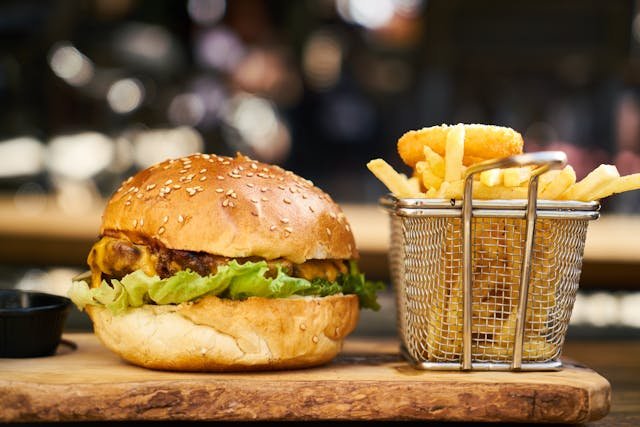
Your digestive system is hardworking, but it’s also sensitive. It notices what you eat, how you eat, and even how you feel when you’re eating. And if something doesn’t sit right — your belly will tell you.
Let’s explore the most common things that upset digestion, and how to avoid them gently.
1. Eating Too Quickly
When you eat too fast, your stomach doesn’t get a chance to catch up with your mouth.
This can cause:
- Bloating
- Gas
- A heavy or uncomfortable feeling
When food isn’t chewed well, your stomach has to work extra hard to break it down. That can slow digestion and even cause hiccups or heartburn.
What to do instead:
Slow down. Chew your food all the way. Enjoy the taste and take small bites. Your tummy will thank you.
2. Overeating (Even Healthy Food)
Too much food at once can stretch your stomach and slow everything down. This makes it harder for your digestive system to do its job.
You might feel:
- Sleepy
- Sluggish
- Too full
- Or have a tummy ache
What to do instead:
Listen to your body. Stop eating when you feel full — not stuffed. It’s okay to save the rest for later.
3. Too Much Junk Food
Sugary snacks, fried foods, soda, and highly processed meals don’t offer your body much fuel. They are also harder to digest, especially when eaten often.
These foods can lead to:
- Constipation
- Belly aches
- Gas and bloating
What to do instead:
Balance your treats with fresh foods that are kind to your body — fruits, veggies, whole grains, and fiber-rich snacks.
4. Not Drinking Enough Water
Water helps your digestive system move food smoothly. Without it, everything gets slower and harder.
This can cause:
- Constipation (trouble going to the bathroom)
- A dry mouth
- Sluggish digestion
What to do instead:
Sip water all day long. If you’re feeling tired or stuck in your belly, a glass of water may help more than you think.
5. Sitting Too Long
When you sit or lie down too much — especially after meals — digestion can slow down.
This might lead to:
- A heavy feeling in your stomach
- Trouble going to the bathroom
- Less energy
What to do instead:
After meals, sit for a few minutes to let your food settle — then move! Go for a walk, stretch, or play outside. Movement helps digestion flow.
6. Stress and Worry
Your brain and belly are best friends. So when your brain is feeling upset, your stomach feels it too.
Stress can lead to:
- Upset stomach
- Nausea
- Trouble digesting
What to do instead:
Before eating, take a few deep breaths. Talk about your feelings. Listen to music or spend quiet time if you’re anxious. Eating when calm helps digestion work better.
7. Not Sleeping Enough
Sleep is when your body rests and repairs — including your digestive organs.
Without enough sleep, you may feel:
- Bloated
- Unbalanced
- Hungrier than usual
What to do instead:
Keep a steady sleep routine. Try to go to bed around the same time each night. Your body works best when it gets the rest it needs.
At Debsie, we help kids understand not just what digestion is, but how to work with it. We make science real, personal, and joyful — so children become curious about their own bodies and how to care for them.
How Your Body and Mind Work Together During Digestion
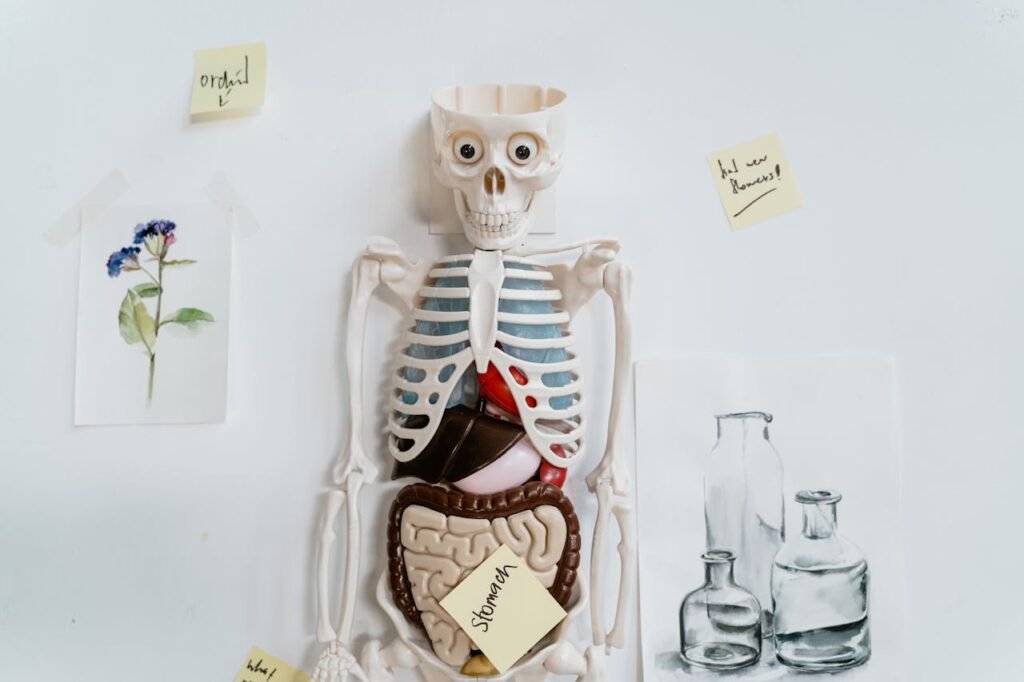
Your body doesn’t work in parts. Everything is connected. That’s why your thoughts, feelings, and movement can all affect your digestion — even though digestion happens quietly inside your belly.
Let’s take a closer look at how each of these things works together.
1. Your Feelings Talk to Your Belly
Your belly and your brain are best friends. In fact, they’re always sending messages back and forth through a special road made of nerves.
That’s why when you feel scared, excited, or nervous, you might also feel something in your tummy.
- Nervous before a test? You might feel like you don’t want to eat.
- Feeling scared? Your belly might hurt, even though nothing is wrong with your food.
- Super happy or excited? You might eat faster without thinking, which can upset your digestion.
The belly listens to how you feel. So when your mind is calm, your digestion works better. That’s why deep breathing, talking about your feelings, or even hugging someone can help your stomach feel better too.
2. Movement Helps Your Food Travel
Once food goes into your body, it doesn’t just sit there. It needs to move through your digestive system — from your stomach, to your small intestine, to your large intestine, and then out as waste.
But your body doesn’t move the food with wheels or tracks. It uses muscles that gently squeeze and push food along.
When you move your body — like when you walk, stretch, or play — it helps those digestive muscles do their job better. Movement makes everything flow more smoothly.
That’s why kids who move often:
- Feel less bloated or “too full”
- Have easier bathroom trips
- Get less tummy pain
But remember — right after you eat, your body wants to rest and start digesting. So no jumping or running right away. Give your belly a few minutes to settle. Then, gentle movement is great for helping digestion finish its job.
3. Water is Like Oil for a Machine
Imagine your digestive system is like a water slide. Water helps things move easily and gently.
Now think about what happens when there’s no water on the slide — things stick and get stuck, right? That’s what happens in your digestive system if you don’t drink enough water.
Drinking enough water:
- Helps your food turn into soft, easy-to-move mush
- Makes it easier for nutrients to be absorbed
- Keeps poop soft and easy to pass
If you don’t drink enough, digestion slows down. You might feel heavy or backed up. That’s why sipping water all day is one of the simplest ways to take care of your belly.
4. Good Food Makes Good Digestion
Your stomach is smart, but it needs good ingredients to work its best.
Foods that are full of fiber, vitamins, and water help your digestion stay strong. These include:
- Fruits (like apples and pears)
- Veggies (like carrots and broccoli)
- Whole grains (like oats or brown bread)
- Beans and nuts (if you’re not allergic)
These foods help clean your insides and give your belly a nice rhythm.
But too many greasy, sugary, or heavily processed foods can confuse your belly. They’re harder to break down, and they don’t give your body much fuel.
Eating well doesn’t mean being perfect. It means learning what makes your body feel good and choosing more of those foods.
5. Calm and Rest Are Part of Digestion Too
Your digestive system doesn’t like to rush. It works best when your body is calm.
That’s why chewing slowly, sitting down while you eat, and resting afterward helps your stomach feel safe and supported. If you eat while walking or feeling anxious, digestion slows down.
Sleep also plays a big role. At night, your body does a lot of behind-the-scenes work to repair your organs, including your digestive system.
So rest isn’t lazy — it’s part of how your body stays strong and healthy inside.
How Debsie Makes the Digestive System Easy to Understand

At Debsie, we don’t believe in boring science classes filled with big words and long definitions. Instead, we believe in something much better: real understanding, real excitement, and real learning that feels like play.
When it comes to teaching kids about the digestive system, we use smart, simple, and joyful techniques that help kids truly understand what’s happening inside their bodies — and remember it for life.
Here’s how:
1. Learning Through Stories and Imagination
Instead of just saying “food travels from your stomach to your intestines,” Debsie teachers bring the story to life.
We might say:
“Imagine you’re a little piece of toast. First, you get chewed up by strong teeth. Then you slide down a warm, wet tunnel called the esophagus. Next, you land in a bubbly hot tub — the stomach! And after that, you ride a long, twisty slide — the small intestine — where you get turned into energy!”
When kids see the science as a story, they don’t just memorize facts — they feel them. It becomes personal, playful, and sticky in the brain.
2. Hands-On Activities That Make It Real
At Debsie, we use simple materials to bring big ideas to life.
For digestion, kids might:
- Build a model digestive system using a sandwich bag (for the stomach), banana and crackers (as food), and pantyhose (for the intestines!)
- Use markers to draw their “digestive journey” on paper bodies
- Create silly skits showing food moving through the body
- Count their heartbeats or measure their breaths before and after meals
When kids touch, move, and create, they learn with their whole body — not just their eyes and ears.
3. Connections to Real Life
We don’t just teach what digestion is. We help kids answer:
- Why do I get a tummy ache sometimes?
- What happens when I’m too full or too hungry?
- Why do I need to drink water?
- What foods help my belly feel good?
This makes learning feel relevant and empowering. Kids walk away feeling smarter — and more in control of how they treat their body.
4. Teachers Who Make Science Feel Like Magic
Our Debsie partner teachers are not just smart — they’re heart-smart. They know how to explain things in a way that feels like a conversation, not a lecture.
They meet each child where they are, and help them build confidence — step by step.
Because at Debsie, we don’t just grow scientists. We grow curious, kind, capable kids who feel proud of what they know and who they are.
Final Thoughts: Your Body Is Brilliant — Let’s Help It Shine
Every time you take a bite, your body begins a journey. That food becomes energy, strength, and fuel for everything you do — playing, thinking, growing, and even dreaming.
Now, you understand what happens after that first bite. You’ve seen how food travels, how your body breaks it down, how energy is made, and how waste is cleared. You’ve discovered how feelings, movement, and good habits make digestion even better.
But this isn’t just about food. It’s about listening to your body, being curious about how it works, and learning how to take care of it with confidence.
At Debsie, we help kids like you turn everyday experiences — like eating, breathing, and moving — into powerful science lessons. Lessons that don’t just teach facts, but build real understanding and self-care skills for life.
We make science fun. We make it real. And we make it stick.
Read next:
